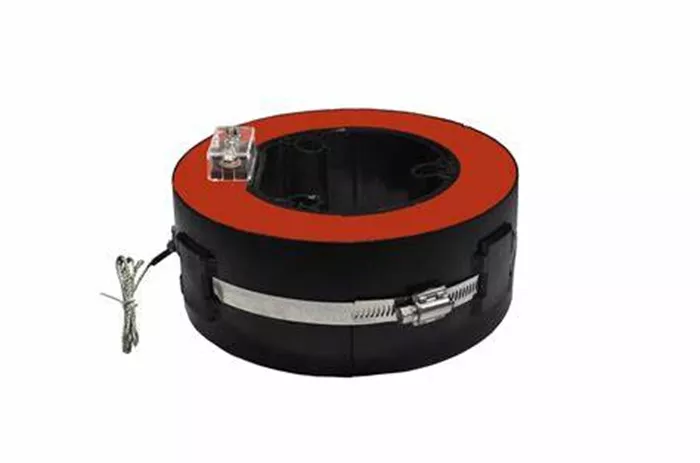Zero sequence current transformer, also known as magnetic core balanced current transformer (CBCT), is a special device used to measure zero sequence current in power systems. These currents are usually caused by system imbalances, such as the failure of electrical equipment such as transformers or motor windings. Zero-sequence current transformers play a vital role in detecting these imbalances, helping power systems identify faults, prevent equipment damage, and maintain reliable operation.
Basic working principle
The working principle of zero-sequence current transformer is based on electromagnetic induction. When zero sequence current is present, it creates a magnetic flux in the core of the transformer. This magnetic flux is proportional to the current flowing through the system. The primary magnetic flux induces a current in the secondary winding that is designed to provide an output current proportional to the primary current. This secondary current is used for measurement or protection purposes.
How is zero sequence current generated
Zero sequence current is the result of an imbalance in the electrical system. These imbalances can occur due to a variety of failures, including:
Ground failure: For example, when part of the insulation of a transformer or motor winding fails and comes into contact with the ground.
Insulation breakdown: In the case of insulation deterioration of electrical components, leakage current will flow through the neutral point of the system, resulting in zero sequence current.
These faults cause the current flowing through the neutral to be unevenly distributed, resulting in a zero-sequence current that is critical for fault detection. Monitoring and measuring these currents helps protect the system from further damage caused by undetected imbalances.
trait
Zero-sequence current transformers offer several advantages that make them an indispensable tool in power system protection and monitoring:
Compact size: The ZCT design is small and lightweight and can be easily integrated into existing power systems without major modifications.
High accuracy: These transformers provide accurate measurement of zero sequence current even under challenging conditions.
Fast response time: ZCT detects faults quickly, ensuring that the protection system can respond in real time to prevent further damage.
ApplyZero sequence current transformers are mainly used in the following applications:
Fault detection
ZCT is widely used to identify ground faults and other anomalies in power systems. By measuring the zero sequence current, ZCT can detect faults in the phase current that may not be visible, ensuring that the system can take corrective action.
Protective relay
The ZCT provides vital inputs to the protective relays, which can then isolate faulty parts of the grid, preventing cascade failures and equipment damage.
System monitoring
These transformers also monitor the overall health and balance of the electrical system, ensuring its efficient and safe operation.
Working principle of zero sequence current transformer
Zero-sequence current transformers operate based on Kirchhoff’s current law, which states that the algebraic sum of currents entering a node must be equal to zero. In practice, this means that when the system is operating properly and without faults, the vector sum of the current in all phases should also be zero, resulting in no output from ZSCT.
However, when a ground fault occurs, this balance can be upset. The fault creates a magnetic flux in the ZSCT’s torus core, which induces a voltage on the secondary side and activates the protective relay. This triggers the trip mechanism, effectively isolating the faulty part to prevent damage and ensure safety.
Selection of zero sequence current transformer
How to choose zero sequence CT current transformer?
Zero-sequence current transformer is generally used in high voltage system, it is a kind of independent system with high ground current. When a system line is grounded, the circuit breaker on the power side of the faulty line is triggered. The fault signal is detected by the zero-sequence current transformer and sent to the protection device to make the circuit breaker trip.
Method of selecting zero sequence CT current transformer
Select according to the maximum ground current of the system: ensure that the protection device can work normally, and the zero-sequence current transformer will not be saturated due to magnetism.
Select according to cable size and type: This ensures compatibility and optimum performance.
Classification of zero sequence current transformers
Zero-sequence current transformers can be divided into two categories:
For measuring zero sequence current in the event of a single phase grounding in a small current system: these are matched with microcomputer selection devices for grounding.
A Zero Sequence Current Transformer for Large Current Grounding Systems (Also Known as Low-Resistance Grounding) Protection: These can be used with protection devices to achieve relay protection.
Installation and Calibration
Proper installation and calibration are crucial for the effective operation of zero sequence current transformers. These devices should be installed in accordance with relevant process standards to ensure accurate detection of zero sequence currents. Calibration ensures that the transformer provides accurate measurements and reliable fault detection.
Conclusion
Zero sequence current transformers are essential in modern power distribution systems, providing a safe, efficient, and reliable means of detecting ground faults and other imbalances. Their unique advantages make them a preferred choice for many applications, ensuring reliable power distribution while addressing safety concerns and noise reduction. By understanding the principles, construction, and applications of zero sequence current transformers, engineers and technicians can better integrate these devices into their systems, ensuring optimal performance and reliability.
Related Topics:

